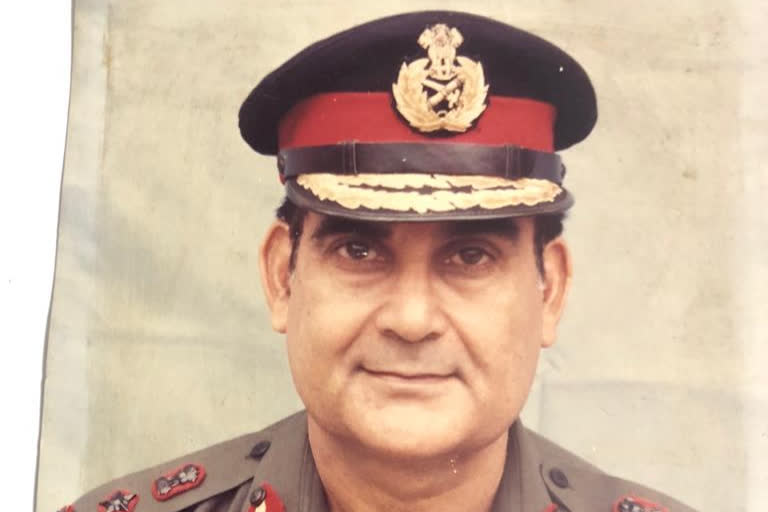Srinagar: As the Amarnath Yatra resumed on Monday, after a devastating cloudburst on Friday, which killed 16 people, Rtd. Brig (Dr) BK Khanna who led the National Disaster Management Authority between 2005-2015 claimed that the tragedy could've been avoided if better arrangements in addition to stricter protocols were in place.
Talking to ETV Bharat, Rtd Brigadier (Dr) BK Khanna, a war veteran and an internationally renowned Disaster Management and Climate Change Adaptation expert who led the NDMA between 2005-2015 said, "Back in 2005 to 2015, every year nearly 100 people used to die while on their route to the holy caves. The J&K Governor back then urged us to look into this issue and we did a deep analysis, and mock drills and issued several guidelines. I was at the National Disaster Management Authority then."
The cloudburst on Friday claimed 16 lives and destroyed an accommodation site at Baltal, this was the same site that Khanna had urged the state government to move further downside. "But my petition was ignored back then. There's a stream there at the site which comes up from the top and merges with the river there," said Brig. Khanna.
Also read: Amarnath Yatra resumes after halt of 2 days; cloudburst claims 17 lives
"Our (NDMC) petition back then was to shift this campsite at Baltal downside by 1 km. The proposed site was close to an army warfare school and there was huge space for accommodation. But the petition was rejected. If that could've been accepted, maybe casualties could've been prevented," said Khanna.
In 2010, the J&K shrine board had requested the state government to build huts for accommodation further down but that request was also ignored and shelved. "I made that petition in 2015 but I think that has come alive now.. there was a likelihood of a calamity...and that calamity occurred there on Friday. I don't know what are the reasons behind not accepting this suggestion but I guess there must be plenty," said Khanna.
Every year, pilgrims come to witness the snow lingam which is formed naturally at the shrine. However, the lingam is yet to form this year. This can be attributed to the negative effects of the surge in heat even in such high-altitude areas. The sudden increase in the number of people visiting the shrine, which was recorded at more than 1 lakh in the past ten days also adds to the problem.
"Due to human heat formation, a local heat cloud came up which then burst due to excessive heat, resulting in excessive rains in a very short period of time," he said. Apart from this, there are many people who organize 'Bhandara' near the shrine, which is yet another factor.
The route to Amarnath via the Baltal area is very arduous. Baltal is located between two mountains and various camps and accommodations sites are set up in the valley between the two mountains. In such a set-up, the excessive rains caused due to the cloud burst washed away all of which were in its way.
Brig. Khanna says a way to solve this problem is to keep a check on the number of people visiting the shrine annually. The number of pilgrims, according to him, should be reduced as 'human heat' is a big factor that is more often than not overlooked by the government authorities.
Talking about the notice issued by the IMD, Khanna said that the IMD can only make predictions and observations, and in high-altitude areas, it is quite difficult to make such predictions accurately. Prior to 2015, the DOPLAR Radar would provide hourly readings for the entirety of the duration of the yatra. The Radar was in use during Khanna's tenure.
Reacting to the media reports which state that the DOPLAR Radar in Banihal has not been functioning for the past 2 years, Khanna said, "this is extremely wrong. This should've been checked before commencing the gates for this pilgrimage. Now, tell me who should be held accountable for that."
He also expressed his concerns about the helicopter services that are in place for the pilgrims. The government service takes off from Pahalgam while the private helicopter service operates from Baltal. He raised concerns about the habit of the private service to leave the co-pilot behind in order to accommodate more people. He said this was a serious lapse in safety precautions and must be checked immediately.
The pilgrimage is open for a mere 43 days, so naturally more people would want to go on the yatra within such a small window. Khanna suggested that the duration of the yatra should be extended to 60-65 days to accommodate everyone without causing overcrowding. He also added the accommodation site at Baltal be shifted further down and the number of annual pilgrims allowed be reduced.



